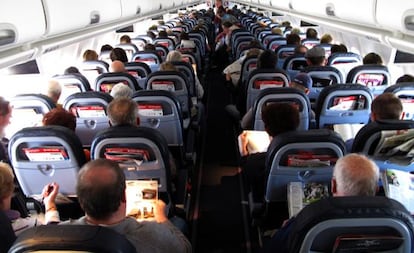Does Spain need legislation to tackle cramped airplane seating?
Researchers say airlines’ money-saving efforts are putting passengers’ health at risk

If you’ve recently taken a flight into or out of Spain, you may well have returned home complaining about your plane seat.
“A normal person can’t fit in a normal airline seat,” says Jordi Porta of the National Physical Education Institute of Catalonia (INEFC Barcelona ) and a member of the International Society for the Advance of Kinanthropometry (ISAK), the study of the human form.
Anybody taller than 174 centimeters can suffer problems when traveling by plane
The size and weight of humans, particularly in the West, has increased “significantly,” according to Porta, something airlines have failed to take into account when designing new aircraft.
Anybody taller than 174 centimeters can suffer problems when traveling by plane, says Pablo Wagner, a physiotherapist and researcher at INEFC and an expert on the ergonomics of tourist class airline seats. Most Spanish men born after 1970 are taller than 176 centimeters.
Airline seats are uncomfortable for anybody of above average height in part because they are short, and partly because they are spaced too close together: the average distance between the inside back of the seat to the rear of the seat in front is around 80 centimeters, although in some planes it is as little as 74 centimeters, says Wagner. Unsurprisingly, low-cost airlines are the stingiest when it comes to leg room. A recent article in The New York Times noted that the distance has shrunk by 10% in the last two decades. As for width, most airline seats measure around 43 centimeters.
“The increase in the number of seats per plane so as to improve profits could be creating a series of problems related to posture and overloading muscles,” says Wagner. María Dolores Cabañas of ISAK says frequent flyers are particularly vulnerable to a range of health issues.
So-called tourist-class syndrome has been known to produce thrombosis during or after flights
Proximity between seats is one of the main complaints passengers make about airline travel, says Heidemarie Hinninghofen of the Tübingen University Hospital in Germany, citing: “difficulties in getting up to move around, breathing difficulties, digestive problems and circulation.” So-called tourist-class syndrome has been known to produce thrombosis during or after flights.
Each airline uses particular types of aircraft. The placement of seats, the distance between rows, and how many passengers there are in each class varies. Spain has no laws establishing the maximum number of seats per plane or the minimum distance between them.
“The companies include the seat, the cushion and the structure of the seat in the measurement, although they shouldn’t, given that we’re supposed to be talking about usable space,” says Gonzalo Saco of INEFC. “It’s a way of hiding the data to prevent us from taking any kind of action.”
Porta says airline seats are still being designed based on the measurements of Leonardo da Vinci’s Vitruvian Man, which takes its name from an architect born in the first century BC. “We’re 2,000 years out of date.”
Improved living standards, the disappearance of many infectious diseases and access to more food have accelerated the growth of children in developed countries, says Antonio Carrascosa, a pediatrician at the Vall d’Hebron University Hospital in Barcelona. His work shows that the parameters of young people aged up to 24 have increased in the last 20 years.
Airline seats are still being designed based on Leonardo da Vinci’s Vitruvian Man, says one researcher
The INEFC, ISAK, and the Spanish Sports Medicine Federation have teamed up to develop the Pitch-Salud project aimed at establishing new average parameters for Spanish men based on 43 variables that include weight, size and leg length. Saco calculates that the distance between seats should be between 83.8 centimeters and 88.9 centimeters.
“We’re hoping that this research will help bring about a change in airline rules,” says Porta.
Cabañas adds: “Shorter passengers have no footrests, taller people’s knees are up against the seat in front, and overweight people are wedged in.” In the meantime, all passengers can do to reduce discomfort and possible dangers to their health is to continue complaining to the airlines, as well as exercising during their flight.
Tu suscripción se está usando en otro dispositivo
¿Quieres añadir otro usuario a tu suscripción?
Si continúas leyendo en este dispositivo, no se podrá leer en el otro.
FlechaTu suscripción se está usando en otro dispositivo y solo puedes acceder a EL PAÍS desde un dispositivo a la vez.
Si quieres compartir tu cuenta, cambia tu suscripción a la modalidad Premium, así podrás añadir otro usuario. Cada uno accederá con su propia cuenta de email, lo que os permitirá personalizar vuestra experiencia en EL PAÍS.
¿Tienes una suscripción de empresa? Accede aquí para contratar más cuentas.
En el caso de no saber quién está usando tu cuenta, te recomendamos cambiar tu contraseña aquí.
Si decides continuar compartiendo tu cuenta, este mensaje se mostrará en tu dispositivo y en el de la otra persona que está usando tu cuenta de forma indefinida, afectando a tu experiencia de lectura. Puedes consultar aquí los términos y condiciones de la suscripción digital.










































